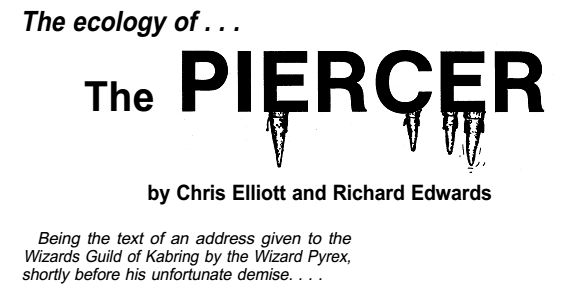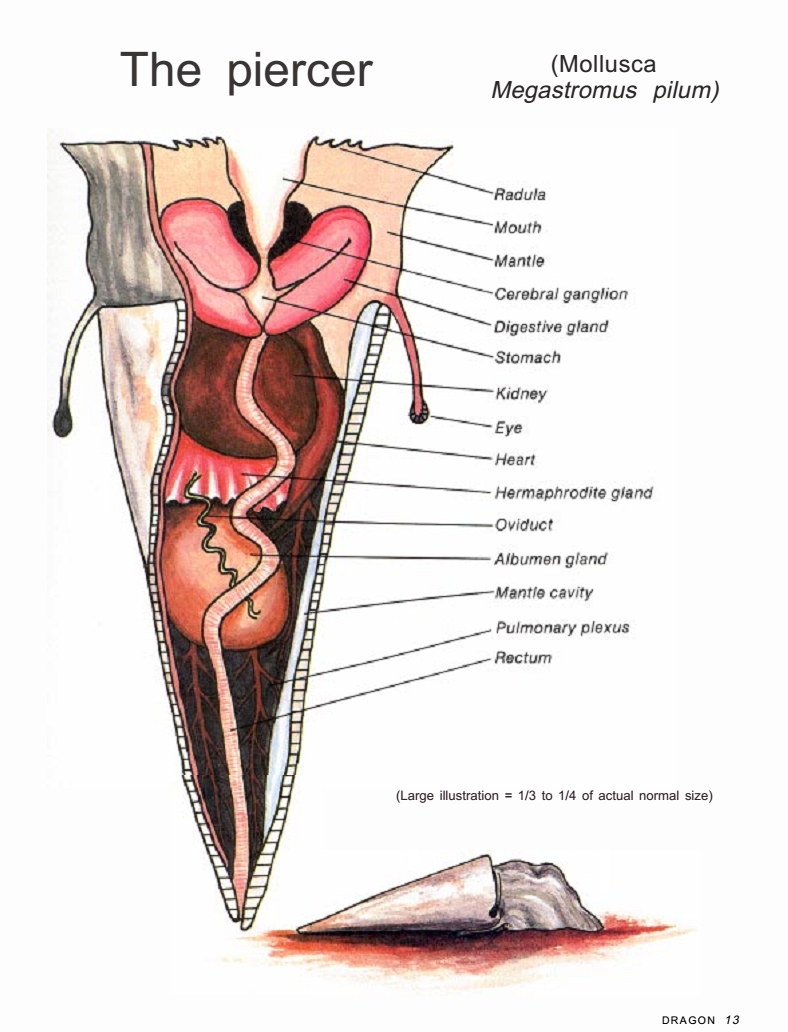
| Dragon | - | Monsters | - | Dragon #72 |
“Brothers and sisters in the arcane arts:
“There can be few here tonight who at
some time in the course of an expedition
underground have not had to leap out of
the way of a piercer launching itself
from
its roost high in the shadows above. If
the piercer misses, it is usually smeared
across the cavern floor. If it hits, it
often
does so with deadly accuracy. Because
of these aspects of its existence, few
people have any real idea of the creature’s
true nature or life cycle. For instance, in the Bestiary of Xygag, the
sage
has this to say about the piercer:
‘ Ye Piercer
doth look like unto a
stalactyte, and
hangeth from the
roofs of caves and
caverns. Unto
the height of a
man, and thicker
than a man’s thigh
do they grow,
and in groups do
they hang. If a
creature doth pass
beneath them,
they will by its
heat and noise perceive it, and fall upon it to kill and
devour it, though
in any other way
they move but exceeding
slow.’
“Hardly pushing back the frontiers of
scholarly analysis, I think you would
agree. Unanswered therein are such
questions as: How does it move? How
does it feed? How, if it attacks only
by
sensing noise and heat, can it be so
deadly accurate? And how, once it has
impaled its prey, does it regain its lofty
perch?
“Well, we now have the answers. After
much careful and often dangerous research
and observation,
I have established the life cycle of this
remarkable
animal, which I shall now relate while
a
number of my assistants illustrate with
conjured images.
“The piercer is a mollusk, hatched
from an egg the size of a hen’s, laid
in
clutches of six or eight in crevices on
cavern walls or floors.
“When first hatched, it resembles a
slug with a rather more pointed tail than
usual, but soon its abrasive tongue is
scouring from the walls not only the
fungi on which the young feed, but grit
and sand. Gradually the grit and sand
are secreted into a rocky shell around
its
body, growing from a thin, sturdy point
to a cone as thick around as a man’s
thigh, as it grows. When the piercer is
about a foot long, it develops the distinctive
adult oculars or eye stalks, which can
be extended from the shell to point back
along it.
“After slowly making its way to the
roof of a cave, the adult piercer hangs
there by its sucker foot, oculars alertly
canted, waiting for its prey. Great patience
is required, but when a creature
passes immediately underneath it, down
it
plummets with fearful accuracy. Normally,
its rocky shell will penetrate most
hides, and it makes a kill.
“What then? I hear you ask. How
do
it feed on its prey, and how does it surmount
the more immediate problem
being stuck bolt upright in a skewer
orc? Fair questions, indeed.
“What in fact happens is that the
piercer must briefly leave its protective
covering, and eat its prey while clear
the shell. Now is when it is at its most
vulnerable — save for when it mates
Whenever possible it prefers to partially
extrude itself from its victim, overbalance,
and then pull its shell clear. This
done, it can feast at leisure on the corpse,
before crawling back to the roof to begin
again the long wait.
“From time to time, two piercers will
make their way to the cavern floor, where
they perform a slow and intricate courtship,
tracing labyrinthine trails in the
dust. At the end of this ritual, they
emerge
briefly from their shells to consummate
their union, and then laboriously return
to their rocky roosts. In due course
another clutch of eggs is laid, and a
other generation of these remarkable
gastropods emerges to continue the
cycle.
“Fellow thaumaturges, I give you
the piercer!”
At this point a rabbit
was released, and was prompt
impaled by a small piercer
previously unnoticed in the
roof. Amid general uproar,
the piercer was revealed to
be an illusion, which
was small consolation to the
rabbit, but was generally
agreed to be a stylish and
highly professional finish
to a fascinating address.
(This article previously appeared in Dragonlords — Yet Another Fantasy & Sci-Fi Roleplaying Magazine.)

Piercer praise
Dear Editor:
I was surprised when I opened DRAGON
#72 and saw a cross section of the piercer. My
first thought was that it must be part of your
annual April foolery. But as I began reading I
found a serious, informative article.
I have never thought of the piercer as a particularly
exciting monster, but Now I have
more respect for it. I too have wondered how
the piercer locates and feeds on prey.
Although I don't think the article was especially
important, it did cover virtually all general
points. Some specific information about
lifespan, maximum time between feedings, and
results of starvation would have been appreciated,
though. For instance, do other animals
or piercers ever inhabit dead piercer's shells?
I would like to see more short articles of this
type and encourage anyone who is so inclined
to make some speculations on the life cycles of
various creatures.
Andy Stone
Mt. Horeb, Wis.
(Dragon #75)
We hoped "The Ecology of the Piercer"
would go over well; based on the reactions
we've received, our hopes were realized. As
Andy and the rest of you realize by now, the
piercer article was just the first of what we
expect will be a long series of "ecology" articles.
If you're considering trying to write one
to submit to us, there are two things you
should know: First, our standards for this
of article are pretty demanding -- in some
ways, even higher than for a "regular" article.
Be real sure you know what you're talking
about, and try not to leave any stones
unturned. Second, we've already got a good-sired
backlog of articles of this type. That
means that even if you write about a monster
no one else has covered yet, and even if it gets
accepted, it might not be printed for a long
time. If you're not discouraged by either or
both of those facts, give it a try.
Obviously, no "ecology" article can be completely
comprehensive; there will always be
things people want to know that neither we
nor the author thought about. And in many
cases, such as the points Andy raises in his letter,
the only way to answer a question is to
take a slightly wild guess. The life span of a
piercer, or how often it needs to eat, are facts
that can't be deduced logically from what we
know, or suppose to be true, about the nature
of the creature. If the situation in your campaign
demands answers to questions like
Andy's, then you're going to have to make a
determination and stick to it. Sure, we could
give you a number -- but we admit we can?t
tell you why a piercer has a life span of (for
instance) five years, instead of fifty or five
hundred. In this respect, the AD&D
world is a
lot like the one we live in: Some questions can
never be answered definitively because we just
don't have, and never will have, enough facts
to be positive we're right.
-- KM
(Dragon #75)

Ah-ha!
I do recall reading "The
Ecology of the Piercer" and enjoying it ![]()
So I stand corrected...sorta at least.
Cheerio,
Gary